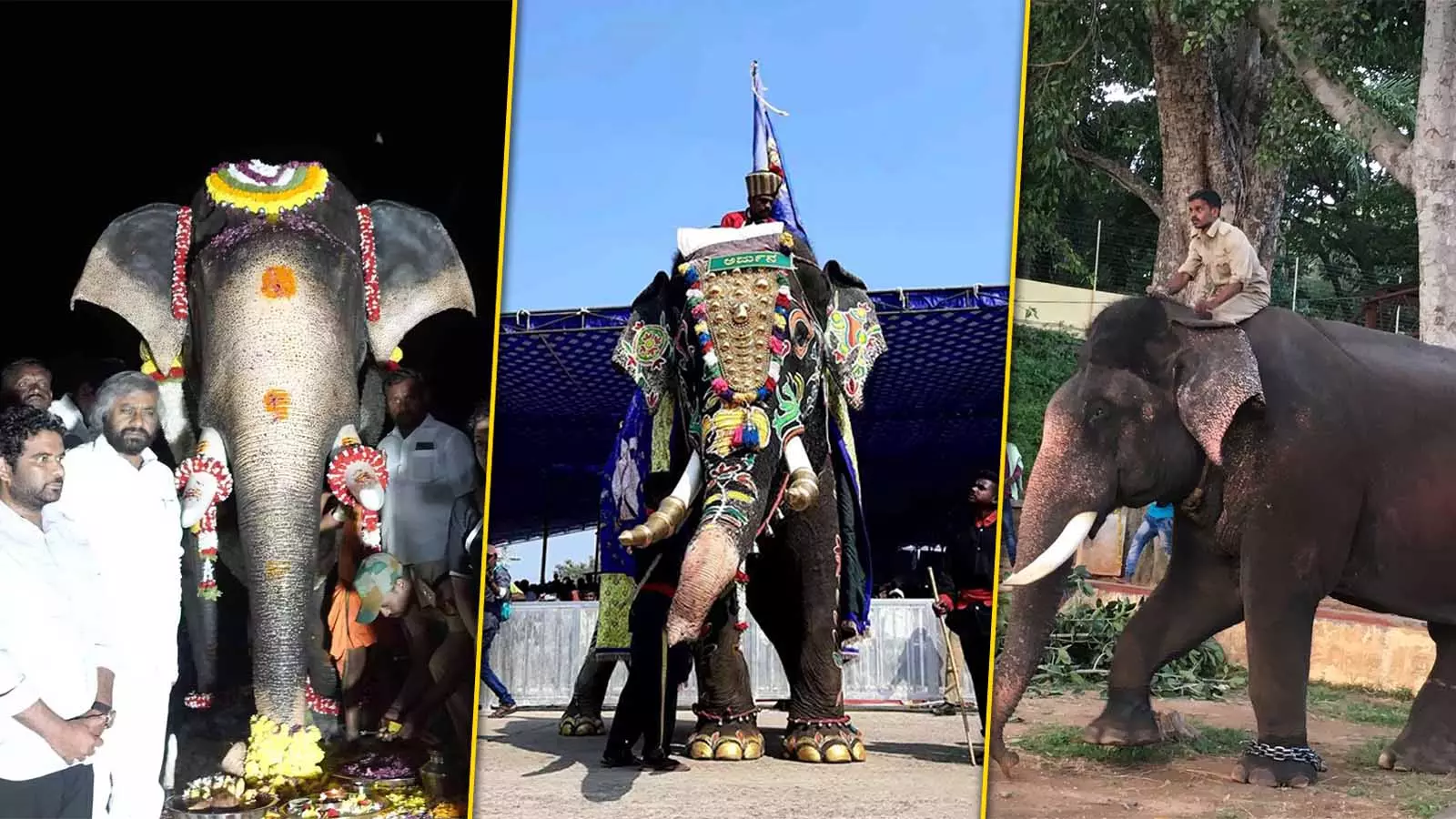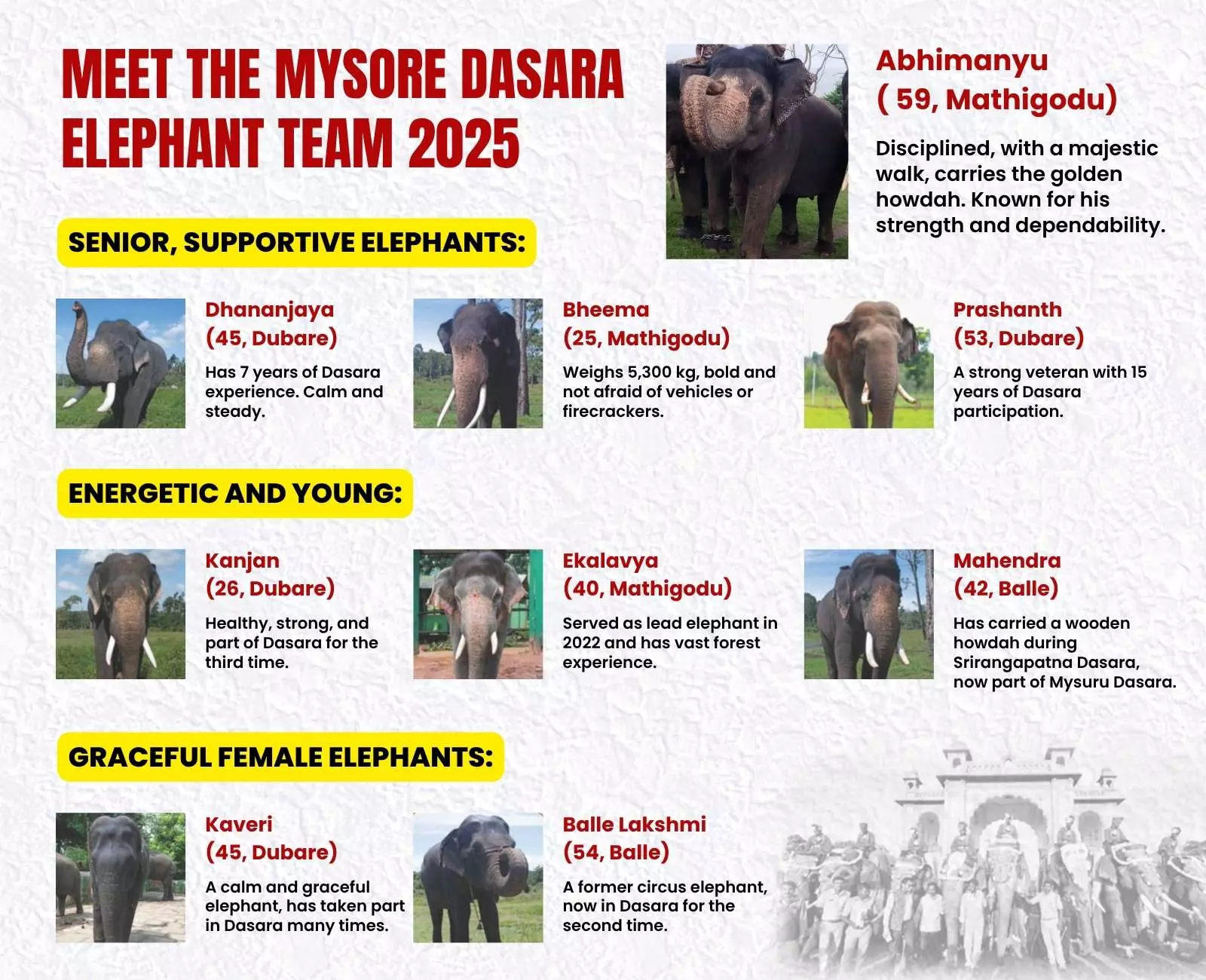
- Home
- India
- World
- Premium
- THE FEDERAL SPECIAL
- Analysis
- States
- Perspective
- Videos
- Sports
- Education
- Entertainment
- Elections
- Features
- Health
- Business
- Series
- In memoriam: Sheikh Mujibur Rahman
- Bishnoi's Men
- NEET TANGLE
- Economy Series
- Earth Day
- Kashmir’s Frozen Turbulence
- India@75
- The legend of Ramjanmabhoomi
- Liberalisation@30
- How to tame a dragon
- Celebrating biodiversity
- Farm Matters
- 50 days of solitude
- Bringing Migrants Home
- Budget 2020
- Jharkhand Votes
- The Federal Investigates
- The Federal Impact
- Vanishing Sand
- Gandhi @ 150
- Andhra Today
- Field report
- Operation Gulmarg
- Pandemic @1 Mn in India
- The Federal Year-End
- The Zero Year
- Science
- Brand studio
- Newsletter
- Elections 2024
- Events
Mysuru Dasara may see Abhimanyu’s last walk as Golden Howdah bearer this year
For over five years, Abhimanyu has led Mysuru’s Dasara procession, carrying the 750-kg Golden Howdah on his back. But as he nears 60, this year’s Nada Habba may mark the final majestic walk of the ‘AK-47 Elephant’

For the people of Karnataka, Mysuru Dasara is more than a festival; it is Nada Habba, a grand celebration of pride, heritage, and identity. And at the heart of this royal procession this year will be Abhimanyu, the majestic elephant who has led the Jumbo Savari, the grand procession held on Vijayadashami, the tenth day of Dasara, for five years, carrying the famed 750 kg Golden Howdah,...
For the people of Karnataka, Mysuru Dasara is more than a festival; it is Nada Habba, a grand celebration of pride, heritage, and identity. And at the heart of this royal procession this year will be Abhimanyu, the majestic elephant who has led the Jumbo Savari, the grand procession held on Vijayadashami, the tenth day of Dasara, for five years, carrying the famed 750 kg Golden Howdah, with immense grace and strength.
His disciplined, majestic walk is a sight people never forget. Abhimanyu’s calm demeanor, unmatched discipline, and heroic missions into the forest to capture wild elephants and tigers amid human-wildlife conflicts, have made him a beloved figure in Karnataka.
Abhimanyu, however, is not alone in the Dasara procession; he leads a carefully chosen team of elephants, each imbued with unique qualities and roles. From the bold Bheema to the calm Kaveri and the experienced Dhananjaya, every tusker in the team carries their own personality, story, and fan following. These gentle giants are not just participants in a parade, they are deeply loved and revered by the people.
What’s unique about the Mysuru Dasara is that it’s not kings who lead the Dasara procession, it’s these wise mammoths. And, in this starry firmament, none shines brighter than Abhimanyu.
The mighty Abhimanyu, who has participated in the Mysuru Dasara for more than 15 years, however, may be walking the grand procession for the last time. Since 2020, after the retirement of the legendary Arjuna, Abhimanyu has been shouldering the Golden Howdah (Ambari) at the Jumbo Savari.
But, as Abhimanyu will soon turn 60, he cannot take part in operations or carry any heavy weights. As per Supreme Court, elephants above 60 years of age can’t do that. So, the big question that lingers in everyone’s heart is this: will this be Abhimanyu’s last Dasara?

Mahout Vasanth with Abhimanyu.
Though forest officers affirm that Abhimanyu is still strong and healthy, things may change next year. That’s why this year’s procession is especially poignant since it will mark an emotional farewell for Karnataka’s famous tusker.
Stories around Abhimanyu are the stuff of legends. He is not only the star of Dasara, but also ruled the forests. When wild elephants created panic in parts of Madhya Pradesh and Chhattisgarh, Abhimanyu, along with his team, spent four months scouring the thick jungles and captured over 70 wild elephants. He gained national recognition for having helped protect remote villages vulnerable to wild elephant attacks.
Also read: How Dharmasthala, Karnataka’s temple town, struggles to shake off its shame
This prominent Kumki elephant has participated in more than 300 elephant capture operations and more than 80 tiger capture expeditions as well. He gained international fame through a documentary called The Last Migration – Wild Elephant Capture, a film that focuses on a 42-day wild elephant capture operation in Madhya Pradesh.
Abhimanyu was first captured in 1970, in a ‘khedda’ operation (a method involving driving herds into a ‘khedda’ or a fenced enclosure, instead of trapping them in pits) at Hebballa in Nagarahole forest. He was trained by a mahout named Shannappa, and later, his son Vasanth, took over his care.
In a conversation with The Federal, Abhimanyu’s mahout Vasanth says he is happy that all of India watches the Jumbo Savari. “Even foreign tourists come to see Dasara and it gives me great joy when people excitedly wave at the elephants during the procession. Children pray to Goddess Chamundeshwari and they are thrilled to see the elephants moving in a line. They beg their mothers to bring them closer to watch. All of this makes my heart brim with happiness,” points out Vasanth.
Vasanth, who affectionately calls Abhimanyu the ‘AK-47 Elephant’, also shares, “In the city, Abhimanyu is calm and never harms anyone. But in the forest, he turns into a powerful tusker, capturing wild elephants and even tigers.”
He has caught more than 200 elephants, he shares, working in Maharashtra, Tamil Nadu, Kerala, and Madhya Pradesh. “In Karnataka, wherever there is a problem with wild elephants or tigers, it is Abhimanyu who is dispatched to catch them. There are many challenges he faces during such operations. This time, he even captured a wild elephant which was causing havoc in Hassan. That’s why he is famously called the ‘AK-47 Elephant’,” says Vasanth, who was awarded the Chief Minister’s Medal in 2024 for his work with elephants.

Captured in a 1968 operation at Kakanakote, Arjuna, who passed away on December 4, 2023, carried the Golden Howdah eight times. He earned much praise for his discipline and strength.
When Vasanth takes charge of Abhimanyu, the huge tusker meekly listens to his master like “a child” and is prepared to take on any challenge for him. Abhimanyu is also a quick learner, he says since in the 1970s, he used to load timber onto trucks and picked up the skills quickly. He shows leadership when other elephants panic, and is even known to sense when tigers are in the vicinity.
During Dasara, Abhimanyu steals the hearts of hundreds. Before the Jumbo Savari begins, when the national anthem and state anthem are played, Abhimanyu proudly stands on his two front legs and raises his trunk in salute. Having learnt to do this from experience, this feat always makes the crowds go wild with joy.
What is special about Abhimanyu is that despite the loud cannon sounds, clicking cameras, and lakhs of people around, he remains unruffled and calm. Right now, Abhimanyu is fit and healthy. He weighs 5450 kg, stands 2.74 meters tall, and has the perfect flat back needed to carry the howdah. He can easily walk the full 5.2 km route from Mysuru Palace to Bannimantap.
Elephants, who have always carried kings on their mighty backs, even into wars, have been part of the Mysuru Dasara for many years. Their importance is underscored by the fact that they lead the Dasara processions instead of the kings.
Over the years, elephants like Jayamarthanda, Vijaya Bahadur, Ramprasad, Motilal, Gajendra, Biligiri, Drona, and Airaavata and Balarama, have become famous participating in the Mysuru Dasara for more than 30 times. They all have their own stories.
Abhimanyu, who now carries the howdah, is part of this rich legacy. The names of these pachyderms are forever etched on the palace walls and history books. One such elephant that is fondly remembered is the late Arjuna.
Captured in a 1968 operation at Kakanakote, he was trained to participate in the grand Mysuru Dasara and carried the Golden Howdah eight times. He earned much praise for his discipline and strength. Sadly, Arjuna passed away on December 4, 2023, due to age-related health issues at the Balle elephant camp in Nagarahole Tiger Reserve. His death was mourned across Karnataka, especially by those connected to wildlife and the Dasara celebrations.
After Arjuna’s passing, his successor Abhimanyu took over as the lead elephant for Dasara. The selection of the 25 elephants that Abhimanyu will lead in the Dasara procession is currently in full swing. It is a rigorous process. Health check-ups have become mandatory after Lakshmi, an elephant chosen for a Jumbo Savari one year, gave birth to a calf inside the palace grounds during the Dasara preparations.
Environmentalists and wildlife experts slammed the inclusion of a pregnant elephant in a procession and blamed the negligence of forest officials. A similar incident happened in 1984 when Sarala, another elephant, gave birth during Dasara.
Unwilling to take any chances this year, the forest department has sent the urine, dung, and blood samples of the elephants to the 130-year-old top research institute, the Indian Veterinary Research Institute (IVRI) in Bareilly, Uttar Pradesh, for general health tests and to test for pregnancy.
Also read: How Bengaluru’s garbage is ruining lives of villagers in Karnataka’s Doddaballapur
The elephants’ mahouts and caretakers are interviewed, too, since they are most familiar with their wards. Local veterinarians also examine the elephants and submit their reports. Based on all these findings, the elephants who will follow Abhimanyu in this celebrated procession are picked.
Speaking to The Federal, forest officer Dr I B Prabhugowda says, “We are being very cautious in choosing the elephants. We’ve identified 25 elephants and are conducting tests and the final list will be released by the forest minister.”
Meanwhile, some of the elephants who are already selected for Jumbo Savari are given special training and are treated with care. Every day, mahouts and caretakers walk the elephants 5 km from the palace to Bannimantap.

Abhimanyu, who carries the Golden Howdah, will train with 750 kg sandbags. Firecrackers and mock cannon sounds will also be used during training so elephants don’t panic during the actual event. As Dasara begins, the elephants will be adorned with elaborate decorations, including Shanka, Chakra, Surya Chandra designs, Gandaberunda on the trunk, and floral patterns. These decorations, applied with natural colours, include white outlines filled with yellow, red, orange, and green.
The elephants also wear jewellry, headgear, and colourful fabrics, enhancing their regal appearance. After the Dasara festival, the elephants continue to be the guests of the palace for a few more days.
During Dasara, elephants are treated like royalty and people flock to catch a glimpse of these celebrities. But what happens when they return to the forest? Speaking to The Federal, Savitha Nagabhushan of People for Animals (Mysuru) points out, “Wild elephants should ideally not be made to participate in Dasara. But since this is a long-standing tradition, it cannot be stopped suddenly.”
She adds that while elephants are cared for well during Dasara, once they return to the forest, there are changes in their mental and physical state. After getting used to easy food and rest, they may gain weight. Once back in the wild, adjusting to natural food takes time, and weight loss may happen, affecting their health. Hence, the government must monitor elephant health before and after Dasara too, warns Savitha.
It appears that this may indeed be Abhimanyu’s last walk of fame in Mysuru’s Dasara festivities. “Though he is still fit right now, we’ll take a decision next year about his retirement,” the deputy conservator of forests, Prabhugowda tells The Federal.
Elephants like Dhananjaya, Mahendra, Ekalavya, and Kanjan are the likely candidates to replace “Mr Reliable,” as Abhimanyu is often affectionately called by his admirers.
